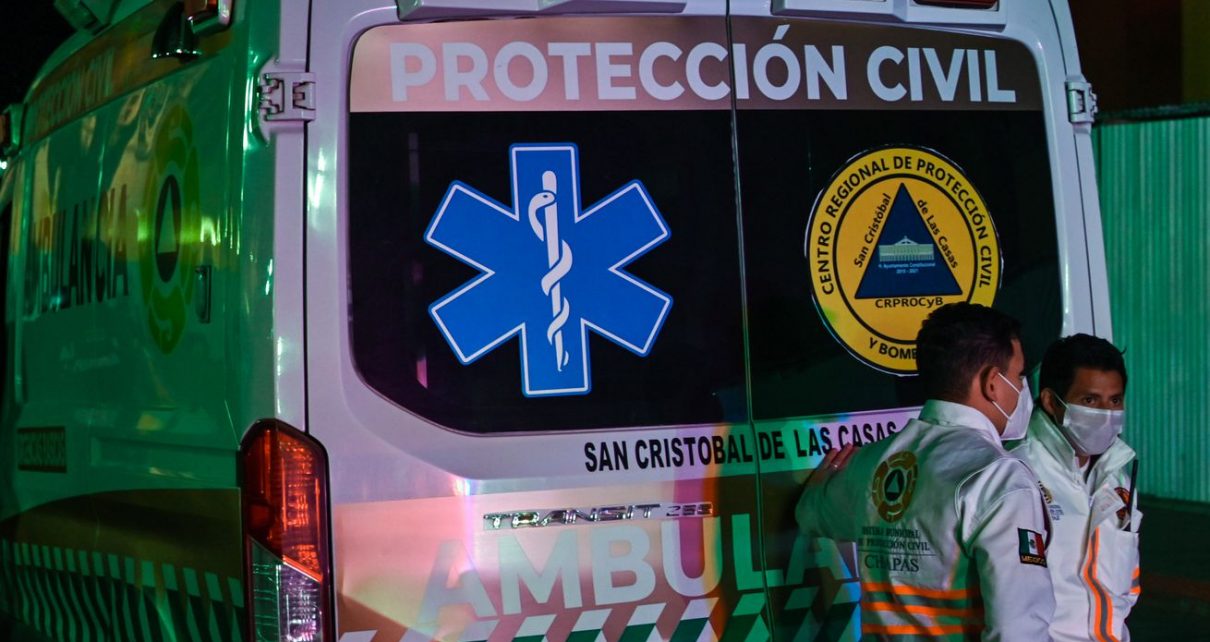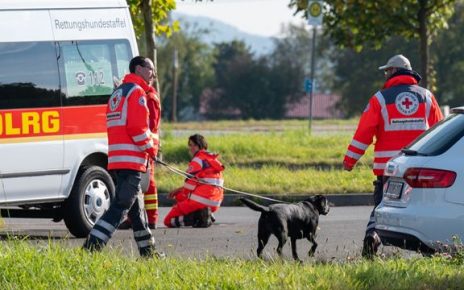
US border policies have left them stuck in Mexico without adequate health care access.
Much like in the US, omicron has led a spike in caseloads and hospitalizations across Mexico. For thousands of migrants stranded in the country due to US border policy, that has meant exposure to the highly contagious variant. Worse, many of these migrants face the prospect of Covid-19 infection without widespread access to vaccines or health care.
Migrants are legally entitled to public health care in Mexico, but nonprofits serving migrants say hospitals are overwhelmed by Mexican Covid-19 patients, and as a result, migrants are the first to be turned away.
Neither the US nor the Mexican government provides data on the number of migrants stranded in Mexico. But the data that is available provides some clues. For one, asylum applications in Mexico rose sharply in 2021, suggesting that tens of thousands of migrants looking to enter the US have decided to stay in Mexico instead. Last year, there were 131,000 of those asylum seekers. The Biden administration has also expelled migrants at the border more than 1.1 million times since January 2021. Most of these migrants were sent back to Mexico, but some, including nearly 14,000 Haitians, were instead sent back to their home country.
Based on those numbers, the number of people waiting for entry into the US could range from the thousands to nearly 1 million. Many are living in shelters, and in camps in cities such as Tapachula and Reynosa along Mexico’s southern and northern borders, in environments that make social distancing difficult if not impossible. There are NGOs providing them with access to Covid-19 testing and treatment as well as primary care. But those NGOs are increasingly overwhelmed by demand. And there is only so much they can do to prevent the spread of Covid-19 given that many have been unable to secure a supply of vaccines.
“The pandemic isn’t any more significant on this side of the border than it is on the other side of the border,” said Mark McDonald, a project manager for the health care NGO Global Response Management, which operates a clinic for migrants in Matamoros, Mexico. “But resources on the border are still relatively scarce and hospital systems are overrun.”
More than 635,000 people, or about 13.4 percent of those who have tested positive, are currently hospitalized with the virus in Mexico. Hospitals are stretched thin. According to data from the Mexican Ministry of Health, 228 hospitals across the country have reported that more than 70 percent of their beds were in use as of January 26, compared to just 71 hospitals the month before; 125 of those institutions had no available beds. Daily average deaths have more than doubled over the last month to 330 as of January 26, but are still well below their peak of more than 1,100 before vaccines were available. More than 303,000 people have died of the virus since the outset of the pandemic in Mexico.
A shortage of hospital space means many sick migrants don’t have anywhere to go. Many face probable danger if they return home. And they can’t enter the US.
The Biden administration reimplemented the Trump-era “Remain in Mexico” program under court order in December 2021; under that program, those seeking entry into the US are required to wait in Mexico until their immigration court hearings. Migrants are also being kept from entering the US under a pandemic-related border restriction first implemented by the Trump administration known as the Title 42 policy, which allows the federal government to bar noncitizens entry into the US for health reasons. The former policy saw those 267 asylum seekers sent back to Mexico recently, and the latter is responsible for Biden’s 1.1 million expulsions in the past year.
And all those people are more than Mexico can support — particularly amid the current omicron spike.
The country reported more than 44,000 new coronavirus cases on Wednesday, a more than tenfold increase since December. That is likely an undercount due to the scarcity of available tests, and cases are not being measured among migrants specifically. The current hot spots are primarily in tourist destinations, including Baja California Sur, Yucatan, and Quintana Roo, but transmission remains high across the country.
About 60 percent of the Mexican population is fully vaccinated, more or less in line with the US, where about 64 percent population is vaccinated. The US has vaccinated the few hundred migrants subject to the Remain in Mexico program so far before sending them back across the border, with adults receiving the Johnson & Johnson vaccines and eligible children receiving the Pfizer vaccine.
There have also been local vaccination campaigns in cities like Tijuana, where thousands of migrants are staying. But Mexico has not launched a national campaign to get migrants vaccinated because it just doesn’t have the capacity. The US does have the capability to fill this void. It’s chosen not to, however, and has instead offloaded its responsibility for the health of those it’s keeping in legal limbo onto Mexico.
“I think that [the US] has put blinders on and said, ‘We’ve managed whatever crisis may be occurring on the United States side.’ We forget that there’s another side of the border that we’ve also affected,” McDonald said.
Migrants rely on NGOs to access health care
Global Response Management is the only health care NGO serving the migrant community in Matamoros, and right now, it’s seeing a peak in demand: about 30 to 40 patients per day with more on a waiting list. The vast majority of those seeking care are Haitians, but there are also Mexicans from the southern part of the country, Nicaraguans, Hondurans, and Guatemalans.
The clinic is only open Monday through Friday, and while it does have some urgent care capabilities, it doesn’t have the capacity to handle every emergency medical need. For that, it still refers patients to the local hospital system — but if there aren’t enough beds due to Covid-19 patients, migrants are the lowest priority.
Recently, one of the clinic’s patients was in labor with a high-risk pregnancy and was told that the hospital was full. The clinic was able to partner with legal organizations to help get the patient to a hospital on the other side of the border through what’s called “parole,” a kind of temporary permission to enter the US. But that took time that not every patient might have.
“Even emergent patients don’t have the guarantee that they’re going to have access to a standard level of care along the border,” McDonald said.
The clinic has been administering Covid-19 tests, including for new intakes in migrant shelters and for people who have been granted parole into the US. That’s critical to ensuring that migrants aren’t spreading the virus when they are in settings where they can’t abide by social distancing. But those programs are expensive and have been entirely funded by private donors — not by the US or Mexican governments.
Testing is the main preventative measure migrants have access to; vaccines simply aren’t available to most. To the extent that migrants are vaccinated, it’s usually because they have been enrolled in the United States’ Remain in Mexico program and were vaccinated before they were sent back to Mexico. These migrants are in the minority, however. When it comes to vaccination, there’s little NGOs can do to pick up slack from the US and Mexican governments. Global Response Management, for example, can’t administer vaccines on its own without government support because they have not been able to acquire any and they would need more staff.
“We would like to be able to do that. But we’ve also recognized an unwillingness or a failure of the US government to make that possible for organizations like ours,” McDonald said. “It should be their responsibility to make sure that public health is a is a priority.”
Biden can safely resume migrant processing at the border
The best thing that the US could do to support the health of migrants in Mexico would be to allow them to cross the border to pursue their asylum claims.
That would require lifting Title 42. The Biden administration has repeatedly defended the policy in court as a public health imperative, but public health experts have long argued that there is no scientific rationale for the policy. They say it’s always been possible to safely process people at the border throughout the pandemic, but especially so now that the US has vaccines, an ample supply of tests, and evidence to support that good masks work to prevent the spread of the virus.
“Many of us would argue that Title 42 was never justified from the very beginning,” said Dr. Michele Heisler, medical director at Physicians for Human Rights. “Now we have all the tools — it’s just making it even more apparent that this is a political decision.”
The US recently started requiring that all noncitizens crossing the US-Mexico border provide proof of a US-approved vaccination. But migrants might not be able to access those vaccines in their country of origin or in Mexico. The US has the resources to administer vaccines to them and should step up to do so, Heisler said.
Indeed, the US is weighing a broader vaccination program for the migrants that it currently allowing across the border (a group of people that’s a much smaller fraction of the migrant population stranded in Mexico.) Under the program, migrants would reportedly receive their first jab at ports of entry prior to being allowed to cross the border, and a second dose would become a condition of being granted parole while they await their court hearings in the US.
Creating a similar initiative for migrants the US is not allowing to cross would go a long way towards helping reduce infection rates among those trapped in Mexico.
One potential obstacle could be vaccine hesitancy among the migrant population, Heisler said. That was an obstacle in US Immigration and Customs Enforcement facilities due to a lack of trust in detention center medical providers administering the shots. That could be overcome by sending trusted messengers — such as NGOs like Global Response Management that are already serving the migrant population — and culturally competent communication.
But the challenges of rolling out a vaccine campaign for migrants wouldn’t really be any different to those that the US has encountered before in getting its own population vaccinated.
“I think the logistics are pretty straightforward. We’re not in the first year of the pandemic. We know how to do this now,” Heisler said.





